I have a property Tours :
Toursis anObservableCollectionof classTour- Each "Tour" has an
ObservableCollectionPartiesof classPartie- Each
Partiehas anObservableCollectionEquipesof classEquipe
- Each
- Each "Tour" has an
I have 3 menus :
- The first is is bond with the property
Tours - The second must be bond with the
SelectedItemproperty of the first menu (so it has anObservableCollectionof classPartie) - The third must be bond with the
SelectedItemproperty of the second menu. (so it has anObservableCollectionof classEquipes)
Right now, this is the working code :
<StackPanel>
<ListView Name="lvTours" ItemsSource="{Binding Tours}">
<ItemsControl.ItemTemplate>
<DataTemplate>
<Label Content="{Binding Name}" />
</DataTemplate>
</ItemsControl.ItemTemplate>
</ListView>
<ListView Name="lvParties" ItemsSource="{Binding ElementName=lvTours, Path=SelectedItem.Parties}">
<ItemsControl.ItemTemplate>
<DataTemplate>
<Label Content="{Binding Name}" />
</DataTemplate>
</ItemsControl.ItemTemplate>
</ListView>
<ListView Name="lvEquipes" ItemsSource="{Binding ElementName=lvParties, Path=SelectedItem.Equipes}">
<ItemsControl.ItemTemplate>
<DataTemplate>
<Label Content="{Binding Name}" />
</DataTemplate>
</ItemsControl.ItemTemplate>
</ListView>
</StackPanel>
And then I can change the view of the context depending on the SelectedItem of the menus :
<StackPanel Grid.Column="1">
<local:StatistiquesTour DataContext="{Binding ElementName=lvTours, Path=SelectedItem}" />
<local:StatistiquesParties DataContext="{Binding ElementName=lvParties, Path=SelectedItem}" />
<local:StatistiquesEquipes DataContext="{Binding ElementName=lvEquipes, Path=SelectedItem}" />
</StackPanel>
My problem is if my menus becomes Usercontrol, I can't seem to make the databinding between the menu and the ListView (that I named : lvMenu) inside the MenuUserControl. I though it would be as simple as doing something like this :
<local:MenuUserControl x:Name="MenuTours" DataContext="{Binding Tours}" />
<local:MenuUserControl x:Name="MenuParties" DataContext="{Binding ElementName=MenuTours.lvMenu, Path=SelectedItem}" />
<local:MenuUserControl x:Name="MenuEquipes" DataContext="{Binding ElementName=MenuParties.lvMenu, Path=SelectedItem}" />
And then the context would be reachable the same way :
<local:StatistiquesTour DataContext="{Binding ElementName=MenuTours.lvMenu, Path=SelectedItem}" />
<local:StatistiquesParties DataContext="{Binding ElementName=MenuParties.lvMenu, Path=SelectedItem}" />
...
The lvMenu (the ListView) in MenuUserControl has its ItemsSource="{Binding}" to bind it to the context.
Does anyone have a clue how to do that? (sorry for my english)
